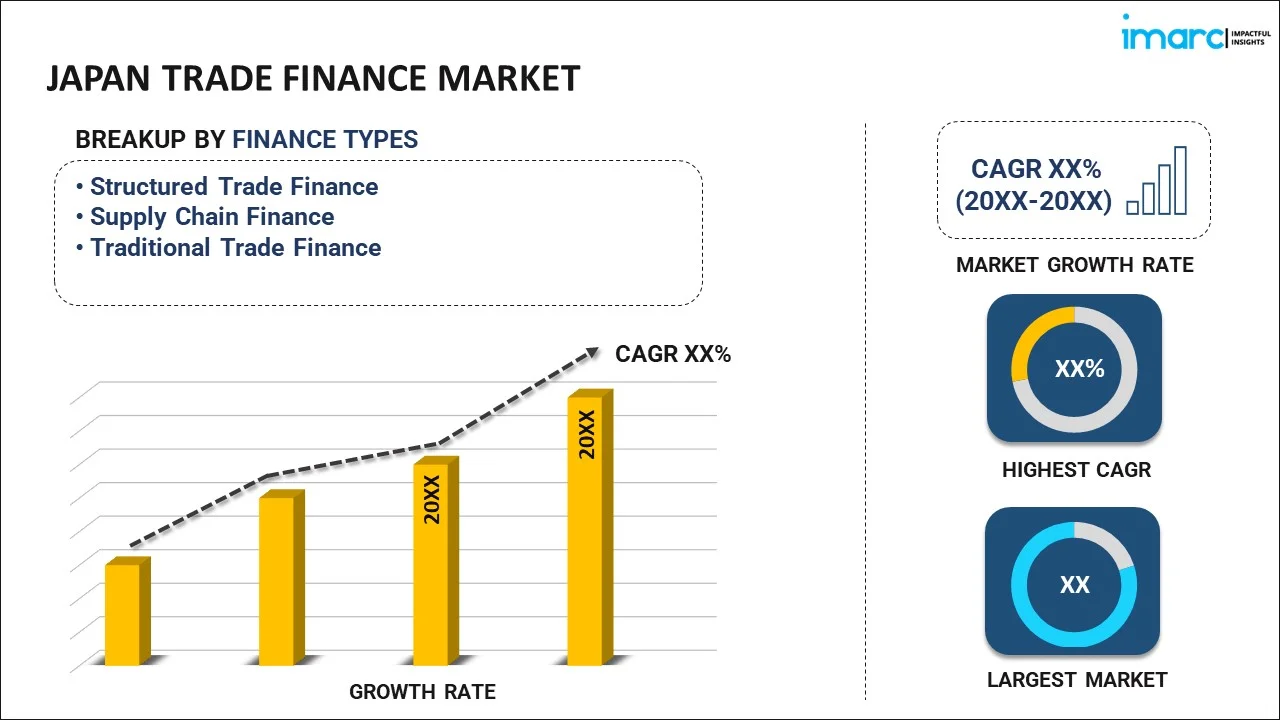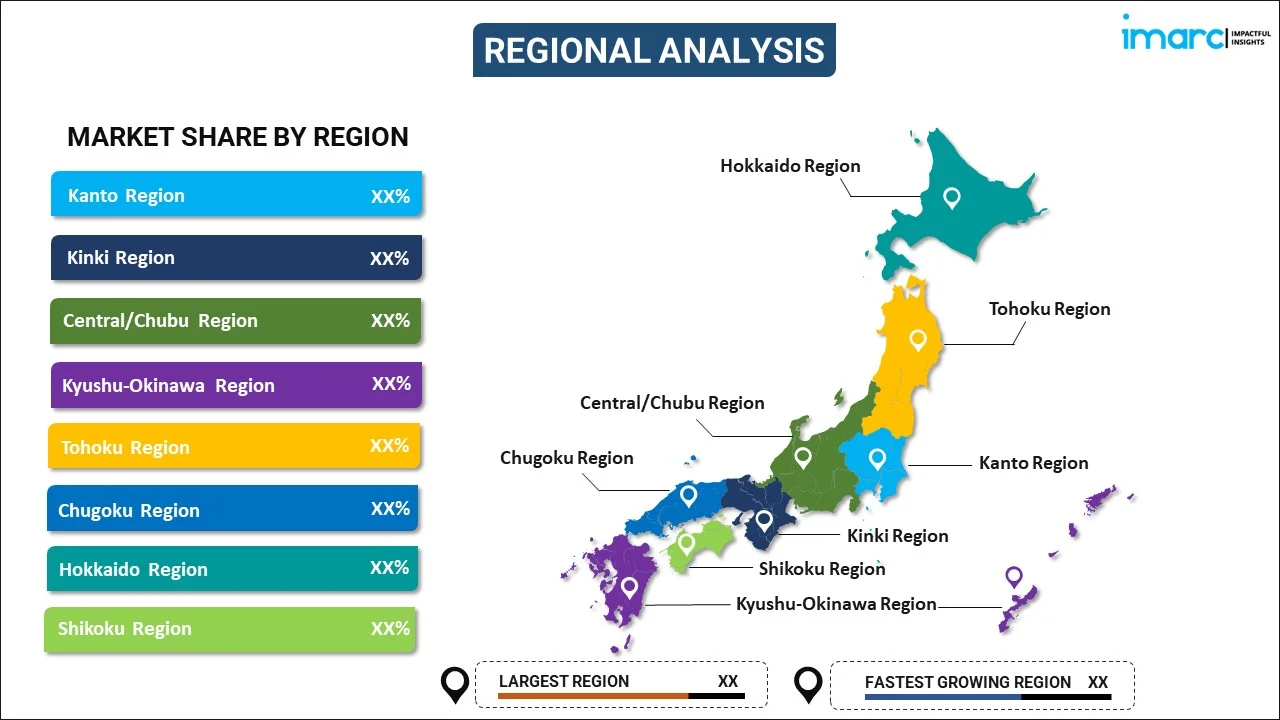
Japan Trade Finance Market Report by Finance Type (Structured Trade Finance, Supply Chain Finance, Traditional Trade Finance), Offering (Letters of Credit, Bill of Lading, Export Factoring, Insurance, and Others), Service Provider (Banks, Trade Finance Houses), End User (Small and Medium Sized Enterprise (SMEs), Large Enterprises), and Region 2025-2033
Market Overview:
The Japan trade finance market size reached USD 3.2 Billion in 2024. Looking forward, IMARC Group expects the market to reach USD 5.5 Billion by 2033, exhibiting a growth rate (CAGR) of 6.2% during 2025-2033. The growing export sector, rapid technological advancements, favorable government regulations and policies, growing international trade, evolving banking sector and the rise of small and medium-sized enterprises (SMEs) represent some of the key factors driving the market.
|
Report Attribute
|
Key Statistics
|
|---|---|
|
Base Year
|
2024 |
|
Forecast Years
|
2025-2033
|
|
Historical Years
|
2019-2024
|
| Market Size in 2024 | USD 3.2 Billion |
| Market Forecast in 2033 | USD 5.5 Billion |
| Market Growth Rate (2025-2033) | 6.2% |
Trade finance represents the financial instruments and products companies employ to facilitate international trade and commerce. It encompasses lending, issuing letters of credit, factoring, export credit, and insurance. Trade finance is essential to mitigate the risks involved in international trade, bridging the gap between exporters and importers. It involves financial institutions, buyers, sellers, insurers, and export credit agencies. Trade finance strategically aligns various financial products to meet specific trade needs. It finds extensive applications in various sectors, such as manufacturing, energy, textiles, automotive, agriculture, technology, healthcare, construction, transportation, retail, hospitality, entertainment, and more. Trade finance also offers numerous benefits, including increased global trade, risk mitigation, provision of liquidity, expansion opportunities for businesses, fostering international relationships, and enhancing economic development. It is employed in various industries due to its flexibility, operational efficiency, credit enhancement, and reduced payment risks.
Japan Trade Finance Market Trends:
The increasing export sector, fueling the demand for financial instruments that minimize risks and facilitate international transactions, is one of the major factors driving the market growth. Additionally, the growing strategic governmental initiatives to bolster international trade relationships and foster collaboration with key trading partners are propelling the market growth. Moreover, the rapid advancement in technology, particularly in FinTech, streamlining and enhancing the efficiency of trade finance processes is creating a positive outlook for the market growth. Besides this, the evolving banking sector in Japan, offering various products and services tailored to international trade needs, is providing a considerable boost to the market growth. In addition to this, the growing emphasis on environmental, social, and governance (ESG) criteria in financing that reflects the increasing trend of sustainable and responsible trade practices is fostering the market growth. Apart from this, the leading position of the country as a major player in various industries such as automotive, electronics, and machinery, promoting the continuous evolution of trade finance, is positively impacting the market growth. Furthermore, the increasing focus on risk management and compliance, vital in navigating the complex regulatory landscape of international trade, is favoring the market growth. In addition to this, the continuous emphasis on innovation and adherence to global standards consolidating Japan's position as a key player in the global trade finance landscape is providing an impetus to the market growth.
Japan Trade Finance Market Segmentation:
IMARC Group provides an analysis of the key trends in each segment of the Japan trade finance market report, along with forecasts at the country level for 2025-2033. Our report has categorized the market based on finance type, offering, service provider and end user.
Finance Type Insights:

- Structured Trade Finance
- Supply Chain Finance
- Traditional Trade Finance
The report has provided a detailed breakup and analysis of the market based on the finance type. This includes structured trade finance, supply chain finance and traditional trade finance.
Offering Insights:
- Letters of Credit
- Bill of Lading
- Export Factoring
- Insurance
- Others
A detailed breakup and analysis of the market based on the offering has also been provided in the report. This includes letters of credit, bill of lading, export factoring, insurance, and others.
Service Provider Insights:
- Banks
- Trade Finance Houses
A detailed breakup and analysis of the market based on the service provider has also been provided in the report. This includes banks and trade finance houses.
End-User Insights:
- Small and Medium Sized Enterprise (SMEs)
- Large Enterprises
A detailed breakup and analysis of the market based on the end user has also been provided in the report. This includes small and medium sized enterprises (SMEs) and large enterprises.
Regional Insights:

- Kanto Region
- Kinki Region
- Central/ Chubu Region
- Kyushu-Okinawa Region
- Tohoku Region
- Chugoku Region
- Hokkaido Region
- Shikoku Region
The report has also provided a comprehensive analysis of all the major regional markets, which include the Kinki Region, Central/ Chubu Region, Kyushu-Okinawa Region, Tohoku Region, Chugoku Region, Hokkaido Region and Shikoku Region.
Competitive Landscape:
The report has also provided a comprehensive analysis of the competitive landscape in the market. Competitive analysis such as market structure, key player positioning, top winning strategies, competitive dashboard, and company evaluation quadrant has been covered in the report. Also, detailed profiles of all major companies have been provided.
Japan Trade Finance Market Report Coverage:
| Report Features | Details |
|---|---|
| Base Year of the Analysis | 2024 |
| Historical Period | 2019-2024 |
| Forecast Period | 2025-2033 |
| Units | Billion USD |
| Scope of the Report | Exploration of Historical and Forecast Trends, Industry Catalysts and Challenges, Segment-Wise Historical and Predictive Market Assessment:
|
| Finance Types Covered | Structured Trade Finance, Supply Chain Finance, Traditional Trade Finance |
| Offerings Covered | Letters of Credit, Bill of Lading, Export Factoring, Insurance, Others |
| Service Providers Covered | Banks, Trade Finance Houses |
| End Users Covered | Small and Medium Sized Enterprise (SMEs), Large Enterprises |
| Regions Covered | Kanto Region, Kinki Region, Central/ Chubu Region, Kyushu-Okinawa Region, Tohoku Region, Chugoku Region, Hokkaido Region, Shikoku Region |
| Customization Scope | 10% Free Customization |
| Post-Sale Analyst Support | 10-12 Weeks |
| Delivery Format | PDF and Excel through Email (We can also provide the editable version of the report in PPT/Word format on special request) |
Key Questions Answered in This Report:
- How has the Japan trade finance market performed so far and how will it perform in the coming years?
- What has been the impact of COVID-19 on the Japan trade finance market?
- What is the breakup of the Japan trade finance market on the basis of finance type?
- What is the breakup of the Japan trade finance market on the basis of offering?
- What is the breakup of the Japan trade finance market on the basis of service provider?
- What is the breakup of the Japan trade finance market on the basis of end user?
- What are the various stages in the value chain of the Japan trade finance market?
- What are the key driving factors and challenges in the Japan trade finance market?
- What is the structure of the Japan trade finance market and who are the key players?
- What is the degree of competition in the Japan trade finance market?
Key Benefits for Stakeholders:
- IMARC’s report offers a comprehensive quantitative analysis of various market segments, historical and current market trends, market forecasts, and dynamics of the Japan trade finance market from 2019-2033.
- The research study provides the latest information on the market drivers, challenges, and opportunities in the Japan trade finance market.
- Porter's five forces analysis assist stakeholders in assessing the impact of new entrants, competitive rivalry, supplier power, buyer power, and the threat of substitution. It helps stakeholders to analyze the level of competition within the Japan trade finance industry and its attractiveness.
- Competitive landscape allows stakeholders to understand their competitive environment and provides an insight into the current positions of key players in the market
Need more help?
- Speak to our experienced analysts for insights on the current market scenarios.
- Include additional segments and countries to customize the report as per your requirement.
- Gain an unparalleled competitive advantage in your domain by understanding how to utilize the report and positively impacting your operations and revenue.
- For further assistance, please connect with our analysts.

 Inquire Before Buying
Inquire Before Buying
 Speak to an Analyst
Speak to an Analyst
 Request Brochure
Request Brochure
 Request Customization
Request Customization



.webp)




.webp)












